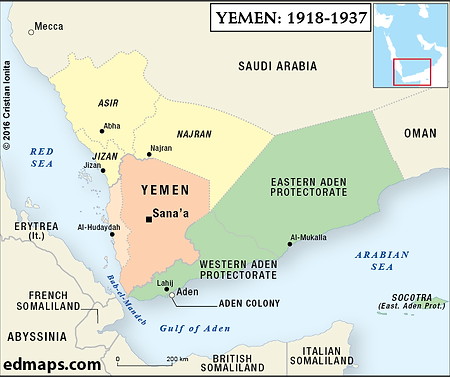HISTORY
A brief history of the Yemen crisis and the civil war's development.
Background
The Republic of Yemen is located on the south western tip of the Arabian Peninsula. It’s northern and eastern regions are bordered by the countries of Saudi Arabia and Oman, while the west and southern regions are bordered by the Red Sea and Arabian Sea. Yemen’s climate is mostly hot and humid along the west coast, where temperatures in the western mountain ranges are affected by seasonal monsoons that occur in the summer months. From west to east, Yemen shifts from its coastal plain on the coast to mountainous terrain and abruptly transitions into the desert plains of the Arabian Peninsula’s desert interior.
Natural resources in Yemen include petroleum, fruit and plants, fish, rock salt, marble, various minerals, and fertile soil in the west. Majority of Yemen’s population identifies as Arab, however there are a variety of ethnicities throughout the country. This includes Africans, South Asians, European, Mahra, and many others. The official language of Yemen is Arabic, but the distinct language of Socrotri (spoken on the island Socrotra) is also spoken.

Map 1: Encyclopedia Britannica (Cartographer). (2012) Encyclopedia Britannica. "Yemen Geography." Retrieved from https://www.britannica.com/place/Yemen
Beginnings
Before Yemen developed into its own country, it was originally territory owned by the Ottoman Empire in the 19th century. At this time, Britain and the Ottoman Empire clashed in conflict for control of Aden and the Suez Canal for trade routes. The Ottoman Empire gained power in Taiz and Sana’a, establishing control in the north, while Britain’s power expanded from Aden throughout the south. A border survey was conducted in 1904 where the two powers signed a treaty to distinguish north and south Yemen.
In 1918, however, the Kingdom of Yemen (North Yemen) gained its independence from the Ottoman Empire at the end of World War I. The British did not dissolve its protectorate area in Aden until 1967, where the People’s Republic of Southern Yemen (South Yemen) began to explore Marxist ideals and declared itself the Democratic Republic of Yemen. In 1970, hostilities and battles raged between North and South Yemen. South Yemen funded opposition movements within the north in the mid-1970s. In 1978, North Yemen’s president, Aḥmad al-Ghashmī, was assassinated and the People Consituent Assembly chose Ali Abdullah Saleh as Ghashmī’s successor.


Map 2 and 3: Ionita, C. (Cartographer). (2016) Edmaps. Yemen Crisis in Five Maps. Retrieved from https://www.edmaps.com/html/yemen_crisis_in_five_maps.html
New Government
Border disputes continued over time until 1990, just after the fall of the Soviet Union in Russia, where the countries discovered oil along the border. Reconciliations and peace agreements were discussed, leading to the unification of Yemen on May 22, 1990. A new multiparty electoral system was agreed upon where parliamentary elections followed in the new democratic atmosphere. However, power sharing and manipulation among Islamist parties led to another civil war that the north won in three months. The political system was then changed to a semi-autocracy, where government officials had little competition in elections.
Saleh passed laws to concentrate decision making powers within the presidency in the new system. These amendments replaced the five member presidential council with the Consultative Council advisory board. Board members were personally selected by Saleh along with the president being able to appoint the prime minister and head of the Judicial Council without additional consultation. As political power grew in the north, Iran began accommodating Yemeni followers of Shi’ite Islam, one of them being Hussein Badr al-Din al-Houthi, in the late 1990s.

Map 4: Ionita, C. (Cartographer). (2016) Edmaps. Yemen Crisis in Five Maps. Retrieved from https://www.edmaps.com/html/yemen_crisis_in_five_maps.html
Rising Divisions
After the three month civil war, the northern regime began to confiscate lands, homes, and natural resources from southern inhabitants and leaders who supported rebellion. These assets along with political power were distributed among loyal clients in the north. Southern secessionist movements led uprisings in 1994 that were quickly subdued, but political corruption was already apparent. In 2004, Hussein Badr al-Din al-Houthi led an uprising in the Sa’dah governorate with a band of rebels known as the Houthi (previously known as the Ansar Allah) with the goal to create more autonomy for provinces in Yemen. This uprising in 2004 led to hundreds of civilian deaths and continued to grow more violent throughout the years.
Since 2006, Al-Qaeda began to spread its influence throughout Yemen by capitalizing governmental instabilities. With tensions of uprising increasing once more in 2007, security forces began unlawfully arresting individuals and journalists suspected of supporting the Houthis while also restricting humanitarian access to certain regions in Yemen. This was done to discourage separatist movements, but only served to fuel them.

Map 5: Ionita, C. (Cartographer). (2016) Edmaps. Yemen Crisis in Five Maps. Retrieved from https://www.edmaps.com/html/yemen_crisis_in_five_maps.html
Protests against Saleh’s presidency began as citizens grew more despondent of the high unemployment rates, poor economic situation, and political corruption. In 2011, just as the Arab Spring was spreading throughout the Middle East and North Africa, the Gulf Cooperation Council (GCC) intervened to mediate the growing crisis. They proposed the GCC Initiative, an agreement where Saleh would step down from power in exchange for immunity from prosecution. Saleh initially refused to sign the agreement, but due to the increase in violent protests he eventually did. His signing of the agreement transferred his powers to his vice president, Abd Rabuh Mansur Hadi, uncontested in 2012.
Civil War
Despite peace and resolution talks that were being launched, there was still an issue of deeply rooted corruption within the government. Yemen launched a National Dialogue Conference (NDC) to discuss and resolve these issues in 2013. In 2014, the Houthis--now led by Abdul-Malik Badreddin al-Houthi--expressed that their grievances were not being addressed by the NDC. The Houthis declared their support of former president Saleh and began a military charged campaign in northern Yemen, leading to the capture of the capital, Sana’a. The Houthis' control of Sana'a and other key government facilities forced Hadi to flee to Aden in February 2015, where he resigned as president and then fled to Saudi Arabia in exile.
Hadi asked the GCC to intervene in Yemen to protect the legitimate government. In March 2015, Saudi Arabia assembled a coalition that began leading airstrikes and on the ground fighting against the Houthi militia. In early 2016, the United Nations attempted peace talks to reduce the amount of airstrikes and fighting, but the talks led to no agreement. In August 2016, the Houthis and Saleh’s political party announced a Supreme Political Council and a National Salvation Government to challenge Hadi’s authority. Dispute grew among Saleh’s political party and ended in Saleh’s death by the Houthis in early December 2017.

Map 6: International Crisis Group (Cartographer). (2020). International Crisis Group. Areas of Control in Yemen. Retrieved from https://www.crisisgroup.org/middle-east-north-africa/gulf-and-arabian-peninsula/yemen/216-rethinking-peace-yemen#map-14434-1
In 2018, anti-Houthi forces reclaimed governorate areas in Yemen. The Houthis and Yemen’s government participated in the first United Nations peace talk since 2016, agreeing to a limited ceasefire in the Al Hudaydah governorate and the establishment of a United Nations Mission to monitor agreement. In August 2019, Hadi’s government clashed with the pro-secessionist Southern Transition Council (STC) in southern Yemen until November where they signed a power-sharing agreement to cease fighting.
In April 2020, the first case of the novel coronavirus (Covid-19) appeared in Yemen in the Hadhramaut governorate. This led to a temporary ceasefire among all forces in Yemen until recently where violence began to pick up again. In July 2020, Saudi Arabia presented a resolution to accelerate the implementation of the Riyadh Agreement, a peace deal between the Yemen government and southern separatist groups. Southern secessionist groups had originally signed the agreement, but soon abandoned it after the Hadi government violated the terms of their cease fire.a
Sources
Data:
Alley, A. L. (2010). Yemen’s Multiple Crises. Journal of Democracy, 21(4), 72–86. https://doi.org/10.1353/jod.2010.0016
Aljazeera (2020). Yemen's Riyadh Agreement: An overview. Aljazeera. https://www.aljazeera.com/news/2020/07/yemen-riyadh-agreement-overview-200729095353381.html
Burrowes, R. and Wenner, M. (2020). Yemen. Encyclopedia Britannica. Retrieved from https://www.britannica.com/place/Yemen
Yemen (2020). CIA World Factbook. Retrieved from https://www.cia.gov/library/publications/the-world-factbook/geos/ym.html
Maps:
Encyclopedia Britannica (Cartographer). (2012) Encyclopedia Britannica. "Yemen Geography." Retrieved from https://www.britannica.com/place/Yemen
International Crisis Group (Cartographer). (2020). International Crisis Group. "Yemen Political and Territorial Divisions as of June 2020." Retrieved from https://www.crisisgroup.org/middle-east-north-africa/gulf-and-arabian-peninsula/yemen/216-rethinking-peace-yemen#map-14434-1
Ionita, C. (Cartographer). (2016) Edmaps. "Yemen Crisis in Five Maps." Retrieved from https://www.edmaps.com/html/yemen_crisis_in_five_maps.html
